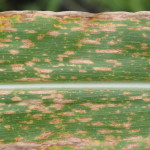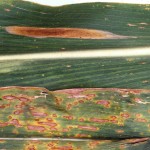by Olufemi Alabi, Assistant Professor and Extension Plant Pathologist, Weslaco and Thomas Isakeit, Professor and Extension Plant Pathologist, College Station
Southern corn leaf blight (SCLB), caused by the fungus Cochliobolus heterostrophus (also known as Bipolaris maydis), has been observed at several locations in the Lower Rio Grande Valley in the fall corn crop this past month. The typical symptoms are oval to slightly elongated lesions, ¼ inch to 1 inch long (Figure 1). On a particular leaf, the lesion sizes and shapes can vary greatly. Typically, the lesions develop initially on the lower leaves and spread upwards. These lesions are much smaller than the elongated (up to 4 inches long) lesions with tapered ends seen with northern corn leaf blight (NCLB), caused by the fungus, Exserohilum turcicum. NCLB is more commonly seen with the spring crop in the Lower Rio Grande Valley and Upper Coast growing areas (Figure 2, comparison of the two blights).
Southern corn leaf blight is favored by rainy weather or frequent, heavy dews and temperatures between 68-90°F. This disease has also appeared in past years in the fall crop, with observations of differences in susceptibility in hybrids. SCLB could be more prevalent in fields that were previously cropped to corn. In susceptible hybrids, a fungicide application may be needed if the disease is present in the upper leaves during flowering or early grain fill. However, there is no data for this area that provides a threshold for a beneficial fungicide application. In a variety trial conducted in Alabama, some of the more SCLB-susceptible hybrids had higher yields than more resistant ones, suggesting that the presence of the disease is not necessarily devastating to yield.
In deciding whether to apply a fungicide for SCLB, the grower should consider the yield potential of the crop in relation to the cost of the fungicide. If the disease is progressing up the plant, an application made around flowering is more likely to have an impact than a later application. A listing of fungicides labeled on corn could be found in this bulletin:
Although the listing was developed for southern rust, most of the fungicides are also labeled for other corn diseases, including SCLB; but check the label to verify. Rotating the field from corn and tillage could also help to break the disease cycle.
If you have any questions, contact Olufemi Alabi at (956) 968-5585 or alabi@tamu.edu; or Thomas Isakeit at (979) 862-1340 or t-isakeit@tamu.edu.

